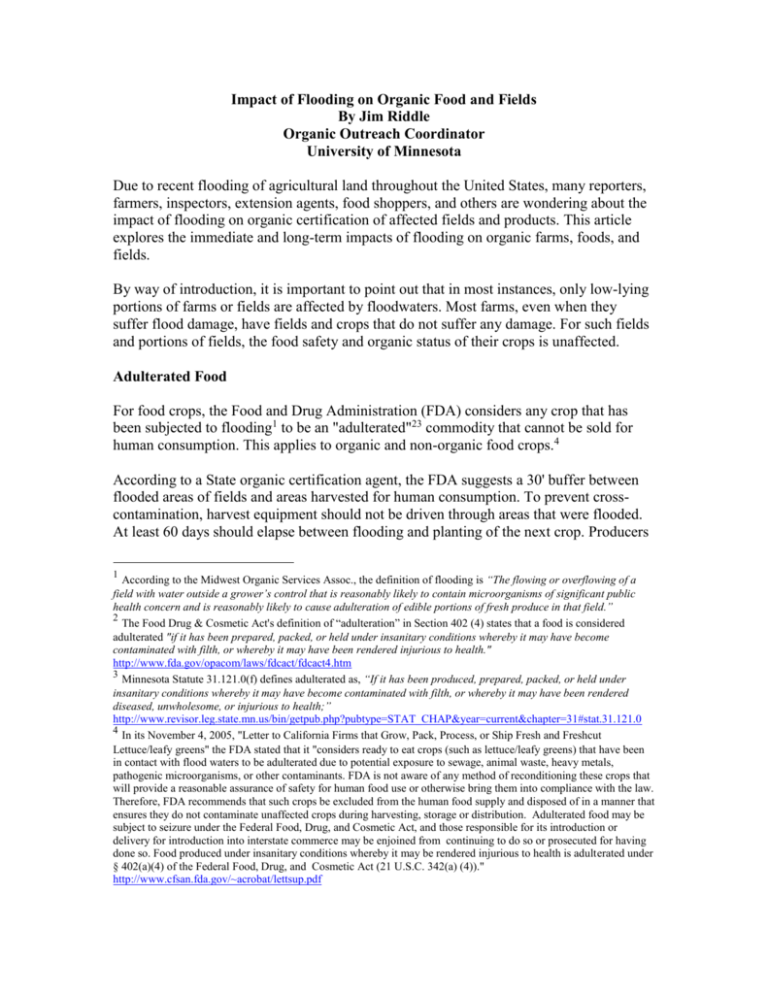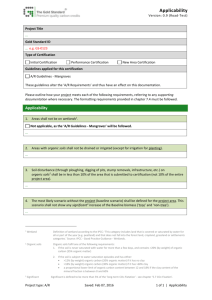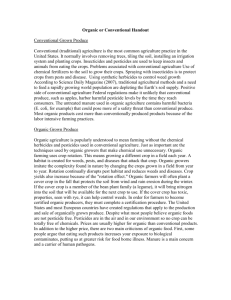Impact of Flooding on Organic Food and Fields
advertisement

Impact of Flooding on Organic Food and Fields By Jim Riddle Organic Outreach Coordinator University of Minnesota Due to recent flooding of agricultural land throughout the United States, many reporters, farmers, inspectors, extension agents, food shoppers, and others are wondering about the impact of flooding on organic certification of affected fields and products. This article explores the immediate and long-term impacts of flooding on organic farms, foods, and fields. By way of introduction, it is important to point out that in most instances, only low-lying portions of farms or fields are affected by floodwaters. Most farms, even when they suffer flood damage, have fields and crops that do not suffer any damage. For such fields and portions of fields, the food safety and organic status of their crops is unaffected. Adulterated Food For food crops, the Food and Drug Administration (FDA) considers any crop that has been subjected to flooding1 to be an "adulterated"23 commodity that cannot be sold for human consumption. This applies to organic and non-organic food crops.4 According to a State organic certification agent, the FDA suggests a 30' buffer between flooded areas of fields and areas harvested for human consumption. To prevent crosscontamination, harvest equipment should not be driven through areas that were flooded. At least 60 days should elapse between flooding and planting of the next crop. Producers 1 According to the Midwest Organic Services Assoc., the definition of flooding is “The flowing or overflowing of a field with water outside a grower’s control that is reasonably likely to contain microorganisms of significant public health concern and is reasonably likely to cause adulteration of edible portions of fresh produce in that field.” 2 The Food Drug & Cosmetic Act's definition of “adulteration” in Section 402 (4) states that a food is considered adulterated "if it has been prepared, packed, or held under insanitary conditions whereby it may have become contaminated with filth, or whereby it may have been rendered injurious to health." http://www.fda.gov/opacom/laws/fdcact/fdcact4.htm 3 Minnesota Statute 31.121.0(f) defines adulterated as, “If it has been produced, prepared, packed, or held under insanitary conditions whereby it may have become contaminated with filth, or whereby it may have been rendered diseased, unwholesome, or injurious to health;” http://www.revisor.leg.state.mn.us/bin/getpub.php?pubtype=STAT_CHAP&year=current&chapter=31#stat.31.121.0 4 In its November 4, 2005, "Letter to California Firms that Grow, Pack, Process, or Ship Fresh and Freshcut Lettuce/leafy greens" the FDA stated that it "considers ready to eat crops (such as lettuce/leafy greens) that have been in contact with flood waters to be adulterated due to potential exposure to sewage, animal waste, heavy metals, pathogenic microorganisms, or other contaminants. FDA is not aware of any method of reconditioning these crops that will provide a reasonable assurance of safety for human food use or otherwise bring them into compliance with the law. Therefore, FDA recommends that such crops be excluded from the human food supply and disposed of in a manner that ensures they do not contaminate unaffected crops during harvesting, storage or distribution. Adulterated food may be subject to seizure under the Federal Food, Drug, and Cosmetic Act, and those responsible for its introduction or delivery for introduction into interstate commerce may be enjoined from continuing to do so or prosecuted for having done so. Food produced under insanitary conditions whereby it may be rendered injurious to health is adulterated under § 402(a)(4) of the Federal Food, Drug, and Cosmetic Act (21 U.S.C. 342(a) (4))." http://www.cfsan.fda.gov/~acrobat/lettsup.pdf also need to monitor the quality of water used for washing food crops to make sure that only safe, potable water comes into direct contact with produce. Certification Requirements The specific National Organic Program (NOP) requirements that may apply to flooded fields and crops are §205.400(f), General requirements for certification; §205.670, Inspection and testing of agricultural product to be sold or labeled “organic”; §205.671, Exclusion from organic sale; §205.201(a)(5), Organic plan requirements for monitoring; §205.272(a), Contact with prohibited substances; and §205.290, Temporary variances. If land is verified as contaminated with prohibited substances and needs to undergo transition to regain eligibility for certification, §205.202 Land requirements, would apply. Residue Analysis Under the NOP regulation, §205.670 states that a certifying agent may require preharvest or post-harvest testing when there is reason to believe that an organic agricultural input or product has come in contact with a prohibited substance. According to §205.671, if a crop is tested for residues and shows over 5% of the EPA tolerance for a given residue on a given crop, the crop cannot be sold as organic. One problem with residue analysis is identifying what to test for. You can test for most pesticides, but it is difficult to test for fertilizers, which are very quickly immobilized by microorganisms and converted to biological forms. You can narrow the search by specifying the most likely contaminants you would expect to find, based on the kinds of crops grown in the area and what inputs are normally used on those crops. Pathogens, such as salmonella and e. coli, can also be present after floods. Food samples, taken from representative areas of fields to be harvested for human consumption, should be tested for human pathogens. If "adulterated" food is going to be diverted as organic livestock feed; if flooded pastures are going to be grazed soon after flooding; or if stored feed, such as large round bales were subjected to flooding, the certification agency may require testing for chemical residues or other prohibited substances. In addition, a farmer may want to test feeds for pesticides, pathogens, mycotoxins, or other contaminants to protect livestock health. Another problem with residue analysis involves the need to take numerous samples from the affected area for the tests to be statistically valid. According to Dr. Francisco Diez, University of Minnesota, “if you want to get 100% assurance of pathogen absence, the number of samples would have to be quite large and given the price of those analysis probably not cost-effective. If you have a field with 500 to 1200 units, you would need to test approximately 80 samples to have a 95% confidence that it would be free from pathogens.” Dr. Diez recommends that any directly affected produce that will not be cooked be discarded. If food is to be cooked before consumption, it should be washed and cooked to at least 165 degrees F. Public laboratories, such as those operated by some universities and state departments of health, agriculture, or environmental quality, should be approached to provide low-cost residue, pathogen, and mycotoxin analysis of food and feed from flooded areas. Temporary Variances Under NOP §205.290, temporary variances from certain requirements may be established for: natural disasters declared by the Secretary of Agriculture (or President); or damage caused by drought, wind, flood, hail, tornado, earthquake, excessive moisture, fire, or other business interruption. Since "flood" and “excessive moisture” are specifically listed under §205.290(a)(2), a certification agency could request a temporary variance from the AMS Administrator. In order to receive a temporary variance, the affected operator needs to make a written request to the certifying agent. The certifying agent reviews the request and may recommend to the AMS that the temporary variance be granted. The AMS Administrator approves the variance and sets a period of time under which the variance is allowed. The Administrator may also grant an extension. The following NOP sections are eligible for consideration when temporary variances are requested: • Soil fertility and crop nutrient practices - §205.203; • Seed and planting stock practices - §205.204; • Crop rotation systems - §205.205; • Pest, weed, and disease management - §205.206; • Wild crop harvesting standard - §205.207; • Origin of livestock, feed, health care, and living conditions - §205.236-239; • Handling (processing) requirements - §205.270; • Facility pest management - §205.271; and • Prevention of commingling and contact w/ prohibited substances - §205.272. In order to be certified with a temporary variance, certain sections of the NOP regulation remain mandatory. These include: • Recordkeeping Requirements - §205.103; • Maintain or Improve the Natural Resources of the Operation - §205.200; • Organic System Plan - §205.201; • No Use of Prohibited Substances - §205.105 and §205.202(a); • No Application of a Prohibited Substance 3 Years Prior to Harvest - §205.202(b); • Distinct, Defined Boundaries and Buffer Zones - §205.202(c); • Labeling Requirements - §205.300-311; and • Certification Procedures - §205.400-406. A temporary variance could apply to management practices (e.g. pastures flooded - have to confine livestock for an extended period of time; crop destroyed - have to deviate from the planned crop rotation and grow the same crop 2 years in a row; or, if a vegetable grower has to replant flooded fields, and has no source of organic seedlings). A temporary variance cannot be used to shorten the transition period, if land loses its organic status due to high levels of contaminants in floodwaters. Future Certification of Flooded Fields If a residue of a prohibited substance is present thru no fault of the operator, the land would not necessarily lose its certification, even if the crop cannot be sold for human consumption or if residues exceed 5% of the EPA tolerance and the crop cannot be sold as organic. The determination regarding the future status of the affected land is made by the certification agency. Generally speaking, low levels of contaminants from floodwater would be considered unavoidable residual environmental contaminants (UREC) under §205.671, and therefore may not affect the land's certification, according to several organic certifiers contacted for this article. However, if there is reason to believe that a high level of contaminants may have been carried in by floodwater due to nearby pesticide manufacturing or another industry producing potential contaminants, it would be advisable to test crops grown on that land the following year to see if 5% of the EPA tolerance is exceeded. As indicated, a farm that is downstream from a source of concentrated prohibited substances, such as a chemical or fertilizer plant or sewage treatment facility that was flooded, would be of great concern regarding prohibited residues. In that case, the land could lose its certification if contamination levels in crops continue to exceed 5% of the EPA tolerance. Certifiers report that they would be most concerned about any areas of a farm where floodwater has collected and deposited sediments. The water that just flows over the land is less likely to leave soluble prohibited substances. Dirt that washes in may be contaminated, however. The time of year the flooding occurred may also be considered, since application of prohibited materials to non-organic neighboring fields tends to occur in the spring and early summer and may be more likely to migrate in floodwater at that time, as compared to flooding that occurs in late summer, 3 months after the application of these substances. The length of time the floodwater was present on the organic fields may also be taken into account when deciding organic certification status and possible long-term contamination. Contact Your Certifier It is critical for organic producers who have experienced flooding to contact their certification agency. One certifier I contacted plans to send a letter to all affected producers in declared flood disaster areas requesting that the agency be informed of the impact on their operations (which fields/facilities; flood duration; standing water duration) and what possible contaminants they can identify. Some certifying agents plan to send out inspectors to operations that have been flooded in order to confirm that flooded produce is not going to market; verify which fields or portions of fields were flooded; identify possible contaminants; and confirm changes to the operation’s organic system plan. Farmers may need to supply information on how they are monitoring their operation to ensure compliance with NOP requirements. The attached forms, developed and supplied by MOSA, may be used as farm monitoring tools. Acknowledgements The following people provided valuable information for this article: Bonnie Wideman, Midwest Organic Services Association; Sam Welsch, OneCert; anonymous State certifier; Emily Brown Rosen, Organic Research Associates; Harriet Behar, Midwest Organic and Sustainable Education Services; Francisco Diez, University of Minnesota; Erin Silva, University of Wisconsin; Meg Moynihan, Minnesota Department of Agriculture; Kevin Elfering, Minnesota Department of Agriculture (retired). 2007 Field Flood Record Office Use Only Field # or storage Acres or location Organic/ Transition Crop or Stored Feed Producer Name_________________________ Flood date and source of water Duration of flood Current status of crop or feed/Comments/Actions taken 2007 Field Plan for all acreage farmed Office Use Only Field # Acres Rent or Own Organic/ Transitional/ Conventional Producer Name_________________________ Crop and Seed Variety Input (such as fertilizer, lime, weed or pest control products and manure) Amount / Rates of Input Used Input Application Dates






